Portland
The settlement on the shore of Casco Bay that became Portland has been destroyed several times and held several names. English naval captain Christopher Levett obtained a land grant in 1623 for a settlement that he planned to name York. Levett went back to England to drum up support but never returned to Casco Bay. In 1633 a fishing village and trading post was established which was named Casco. The Massachusetts Bay Colony took control of the area in 1658, changing the name of the settlement to Falmouth. King Philip’s War, a conflict between hostile Indians and Colonists backed by Indian allies, saw Falmouth destroyed in 1676 by Abenaki Indians. The settlement was not rebuilt until 1678 after the war came to an end. Peace did not last, King William’s War broke out in 1688 between New France and New England with their respective Indian allies. Falmouth was destroyed again in 1690 by French troops and their Indian allies and was not rebuilt for ten years. Fast forward to the Revolutionary War and guess what happened, in 1775 Falmouth was largely destroyed by bombardment from HMS Canceaux. and had to be rebuilt yet again. After the revolution, the part of Falmouth on a promontory between Back Cove and the Fore River known as ‘Falmouth Neck’ underwent rapid growth, and in 1786 the residents renamed that area Portland. The peninsula by the mouth of the Presumpscot River is still uses the name Falmouth, but it has has long been eclipsed by its neighbour, Portland.
Portland Observatory, Congress Street
In the days before radio communications, signal flags were used to communicate between ship and shore. Headlands and islands meant that ship owners had little warning that their ships were approaching Portland, so in 1807 Captain Lemuel Moody built a 26 metre (86 foot) high tower on Munjoy Hill. From this vantage point he could see incoming vessels while they were still on the open ocean. For a fee of $5.00 a year Moody would use a telescope to read identifying flags on the vessels and then give their owners early warning of their arrival. The Moody family operated the Observatory until 1923 when radio communications made it obsolete. The tower was left derelict for several years before being donated to the City of Portland. Portland Observatory was restored and opened to the public in 1939. It is the only maritime signal station still standing in the USA. You may notice the absence of a blue sky in this picture, the day we visited there was sea fog, so it was not worth going to the top of the tower.
Victoria Mansion, Danforth Street
Ruggles Sylvester Morse and his wife Olive came from Maine, but they moved to New Orleans where he made a fortune in the hotel business. They wanted a summer home back in Maine and commissioned architect Henry Austin of New Haven, Connecticut to design it. His design, in the Italian Villa style, was completed in 1860. Morse hired German-trained cabinetmaker and interior designer Gustave Herter to create the interiors in a range of styles. The house had many of the new technologies that Morse had used in his hotels, including hot and cold running water, central heating, and gas lighting. Morse died in 1893 and the following year his widow sold the house with most of its furnishings to dry goods merchant J. R. Libby. The Libbys made few changes to either the decor or structure of the house and lived there until 1929. The house was repossessed In 1939 due to back taxes and left derelict. In 1940 an oil company tried to buy it to replace it with a gas station but William H. Holmes stepped in and bought the house in order to preserve it as a museum. He opened the house in 1941 as Victoria Mansion. It is one of the best preserved Italianate mansions in the US with about 90% of its original interiors intact. Sadly we were not allowed to take interior photographs even without flash, so we can show only the exterior of the house.
Wharf Street, Old Port
You could argue that the British created Portland’s Old Port area as it built during the reconstruction of the city after HMS Canceaux flattened it in 1775. Facing on to the Fore River, the Old Port is known for its cobblestone streets, 19th century brick buildings and waterfront with many piers. Nowadays it is largely a tourist area filled with shops, bars and restaurants.
City Hall
Portland’s City Hall has a history that has echoes the history of the city itself. The first City Hall on this site was built in 1862 only to be destroyed in the Great Fire of 1866. It was Independence Day and it is thought that a firecracker may have been the cause a fire in a boat house on Commercial Street. The fire spread rapidly, destroying 1,800 buildings and leaving 10,000 people homeless but a death toll of only two people. A new City hall was built on the same site, but that burned down in 1908. The current City Hall was designed by New York architect John M. Carrere who based on the design of New York City Hall.
Henry Wadsworth Longfellow House, Congress Street
This house is significant for two reasons; it is the oldest building still standing on the peninsula and it is the childhood home of American poet Henry Wadsworth Longfellow. The two storey house was built between 1785 and 1786 by Revolutionary War General Peleg Wadsworth. It was the first building in Portland to be built entirely of brick. He and his wife raised ten children in the house. In 1807 the house passed to his daughter Zilpah and her husband Stephen Longfellow IV when Peleg retired to his farm in Hiram, Maine. Stephen and Zilpah’s son Henry Wadsworth Longfellow was born in 1807 but this took place in an aunt’s house. The family moved to this house 8 mouths later and Longfellow lived in the house for 35 years. A third storey was added to the house in 1815. Anne Longfellow Pierce, Henry's younger sister, later owned the house until she died in 1901. She kept the house largely as it had been in Peleg Wadsworth’s days. Maine Historical Society took over the Henry Wadsworth Longfellow House and opened it to the public within a year
Click on Minimap to navigate
Home > US States > New England > Maine >
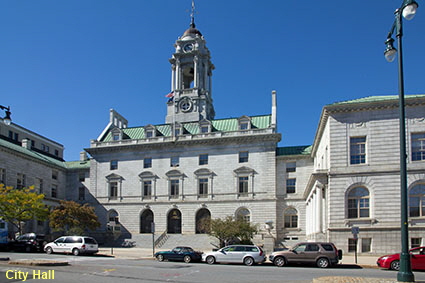
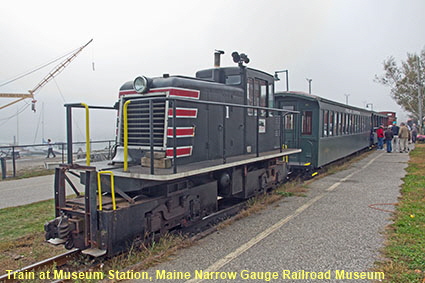
Train at Museum Station, Maine Narrow Gauge Railroad Museum
Narrow gauge railroads were introduced to New England by George Mansfield of Massachusetts after a visit to Wales in the 1870s during which he saw the 596mm (23.5 inch) gauge Ffestiniog Railway which carried slate from inland quarries to the nearest sea port. Narrow gauge railroads are cheaper to build than stanadrd gauge and more suited to difficult terraine, so Mansfield saw potential to use them in rural areas of New England. His first line was the 610 mm (2 foot) gauge Billerica & Bedford Railroad in Massachusetts which reached Billerica in 1877 but ran out of money before the stations were completed and went into liqidation in 1878. Mansfield was undeterred. He switched his focus to Maine where in 1879 he used the track from the B & B Railroad to build the Sandy River & Rangeley Lakes Railroad. It was successful enough to encourage the building of other railroads of the same gauge; the Bridgton & Saco River, the Monson Railroad, the Kennebec Central and the Wiscasset, Waterville & Farmington. In the 20th century all of these lines fell on hard times and the last of them closed in 1943. Portland was not part of the narrow gauge network but the Maine Narrow Gauge Railroad Company & Museum leased a building and 2.5 km (1.5 miles) of trackbed along the shore of Casco Bay. The museum laid narrow gauge track along the trackbed and they provide train rides along it that are an integral part of a museum visit. The museum is open from early May to late October. There are plans to relocate the museum to Gray, about 28 km (17 miles) north of Portland, but at the time of writing no date had been set for the move. Click tab 2 to see a Sandy River & Rangeley Lakes coach in the museum.
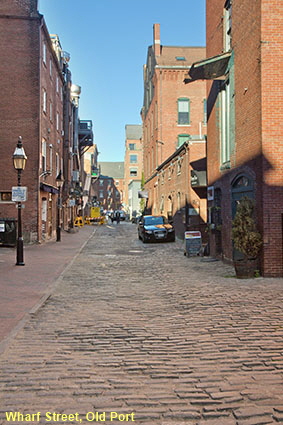
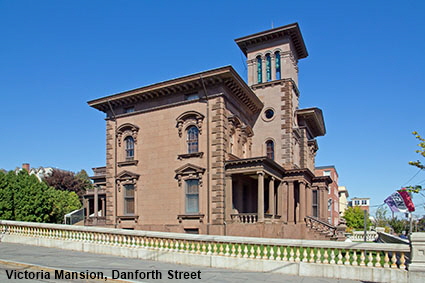
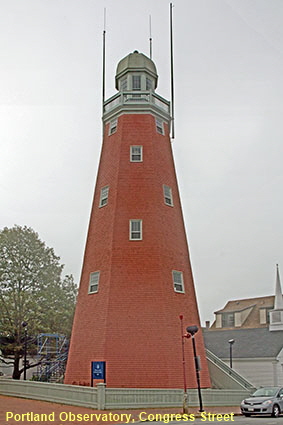
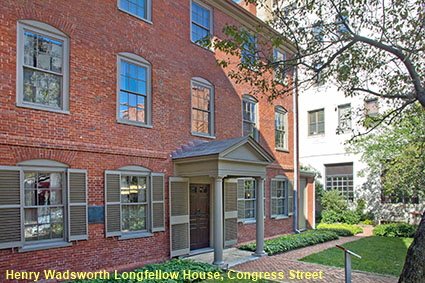
DLU180402


To move forwards or backwards through the Maine trail click the arrows above, or select your next destination on the Minimap.
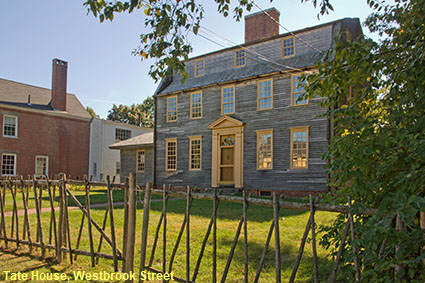
Tate House, Westbrook Street
Captain George Tate and his family arrived in the Colonies around 1750. As Senior Mast Agent for the Royal Navy he was responsible for the selection, felling and shipment of white pines to be used to make masts. Tate was well paid for his work and in 1755 he had this clapboard house built at Stroudwater on the west bank of the Fore River. The house retains its unpainted clapboards and clerestory gambrel roof. Its survival has been helped by its location at the edge of Portland away from the many fires that have over the years affected the downtown area. Tate House is one of few pre-revolutionary house still standing in the Portland area and the only one open to the public. Since 1935 it has been an historic house museum operated by the National Society of the Colonial Dames. The house is open to the public Wednesday to Sunday from June to October. Unfortunately it was a Monday when we were in the area, so we were unable to view the interior.
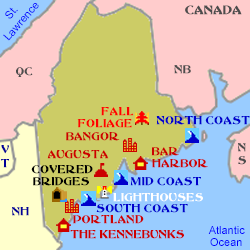

© Mike Elsden 1981 - 2025
The contents of this page may not be reproduced in full or in part without permission